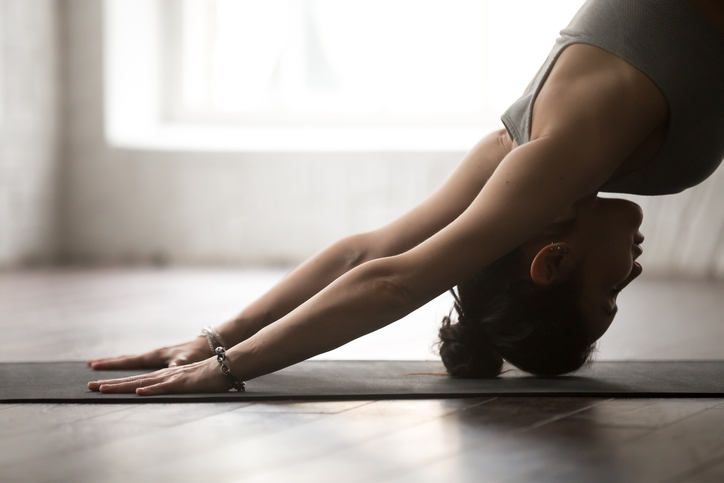
I looked to my yoga practice to connect with my inner calm and sense of well-being long before I was diagnosed with type 1 diabetes at age 23. When that diagnosis struck, I plunged headlong into the study and practice of all aspects of yoga. What I discovered was that the threefold approach of breath awareness, meditation and physical postures combined to bring me a wealth of support.
Breath Awareness
When we bring awareness to the breath it brings great relaxation to the body and mind. It becomes a conduit for the life force to move through the body, enhancing circulation of all that moves in the body: breath/blood/life force. When the body is refueled with the increase in breath flow, the intelligence inside each cell wakes up. It remembers how to function in an optimal way. The inner communication between organs and glands is established anew.
Physical Postures
Each posture, known as an “asana”, serves to promote this energy flow. Hatha yoga is a science. Each posture balances the organs and glands and promotes health in the nervous system, joints and muscles. When these all function well together, health is restored. Most classes, no matter the style, incorporate the key basic postures of Hatha yoga.
Meditation
The one-pointed awareness that comes from bringing attention to your breath and moving in an intentional way in and out of the yoga postures gradually brings a stillness within. From this place, the practice of meditation is possible. Meditation is a deep form of relaxation where the body and mind surrender to the expanse of the present moment. It is said in this state a mystical experience can arise, be it a sense of wonder or a feeling of deep inner calm.
As a “functioning diabetic” I can testify that the inner resources a consistent yoga practice has given me have been an amazing source of strength. Rather than depending on the next internet article, friend to talk to, or outer stimulating experience to give me the signal that everything is OK, I can turn in and tune in. I can bring myself to a place of stability within. This is an inner sanctuary. It becomes more beautiful the more I visit it.
The inner practices, such as martial arts, yoga, and meditation in turn enliven your ability to cope with outer stresses. Yoga provides a stress reduction technique to cope with the physical and mental/emotional stress of living with diabetes.
Physical Benefits
On a physical level, the practice of Hatha yoga helps us to gain flexibility in our muscles and joints. It brings a semblance of balance to our endocrine system. It takes our adrenals down to a normal functioning level. It can help us to maintain a good weight not only through the exercise itself, but the increased body awareness will allow us to tune in and make appropriate choices for foods and quantities we consume.
Emotional Benefits
On an emotional level it can redress the balance when anxiety or the upset of control or lack of control have taken its toll. It can soothe us and help us restore our sense of peace and happiness with things as they are. When our emotional disturbances spiral out of control, it brings pain and confusion to the body. This registers as physical pain which can be reversed through the practice of Hatha yoga. Your body will not only feel better but your emotions will feel balanced and responsive, rather than highly charged and reactive.
Mental Benefits
On a mental level, the ease that comes to the body during and after practice allows us to drop into a deeper mental meditative space where we become aware that we are the witness to the process. We can pick ourselves up and love ourselves as we are. We can have compassion for the job we do daily to keep ourselves in balance. This apparent distancing that happens as we cultivate the witnessing mind, the ability to step back for a few minutes, in meditation, allows us to not react and yoyo ourselves through our glucose control.
Spiritual Benefits
And lastly, on a spiritual level, this increased sense of wonder that arises as we watch how the body, the breath and the mind function so perfectly allows us to align ourselves more with the truth of who we are. We are not our dis-ease. We can create a new relationship with our bodies; we do have a permanent condition in the body which we can learn to treat in a new way, so we work together with our bodies rather than feel that our bodies are working against us.
So How Do You Start a Yoga Practice?
I gained a lot of joy from reading about yoga postures in the beginning. I loved learning what each pose was good for; which organs and glands benefitted, along with the emotional/mental attributes each posture could bring me. I would try some of the poses out at home, reading through the steps in a manual my mother had given me in my teens. Some people find yoga at their gym, others in the variety of yoga centers out there, some through DVDs and YouTube videos. Sometimes local hospitals or health clinics will have yoga classes available as well.
There are many ways for you to step in to the practice of Yoga. If you are more tempted to start with a local yoga studio, here are some things you might look out for:
Hatha Yoga
This is the essence of all yoga. The classes titled Hatha yoga are typically good for all levels, offering a gentle introduction to the postures and ample relaxation between postures and at the end of the sessions.
Hot Yoga
As the name suggests, this class takes place in a heated room. The practice is no more vigorous than the basic Hatha yoga class but the room temperature allows some “colder types” to warm up and enjoy deeper stretches while also experiencing the cleansing effect of a sauna for the pores.
Vinyasa Flow
These classes offer the traditional Hatha yoga postures in a style where each posture flows into the next. The classes are often sequenced with music and can be a fun option for those who enjoy moving their bodies in a dance-like way.
Astanga Yoga
This class involves a set sequence of postures linked together to create intense heat in the body. This is an athletic form of yoga that is practiced daily. It has been proven to be very efficient for decreasing insulin resistance in type 2 diabetes.
Iyengar Yoga
This practice offers detailed alignment principles in the postures. Each posture is examined and repeatedly performed for maximum benefit. The classical postures are taught with an emphasis on their benefits to your health.
Jivamukti Yoga
A vinyasa flow form class infused with spiritual teachings and chants from many traditions.
Kundalini Yoga
A breath focused form of Hatha yoga where different exercises or “Kriyas” are repeated and sustained for a set period of time. Mental endurance is developed.
Basic yoga postures are available to a large range of body types, ages and abilities, and the postures can be modified and suited to the individual. If you have access to an experienced teacher, start taking some beginning yoga classes with them. From there you can explore the wide variety of classes and styles that are now on offer and find the one that is right for you. You will know you have found your match if you feel both energized and relaxed, contented and clear afterwards.
If you have type 1 diabetes or are on an insulin regimen, remember to test your blood sugar before class, during, after, and a couple of hours after class as well.
Caution: practicing yoga may lower your A1C!
Stay in touch with Sarah and learn more about yantras at sarahyantra.com.


Awesome. thank you!
Ashtanga yoga is my favourite yoga.Yoga provides a stress reduction technique to cope with the physical and mental/emotional stress of living with diabetes.
We agree! 🙂
I am practicing Kundalini Yoga. I like it very much. By the way, the reading is impressive. I am going to bookmark this for further assistance. Thanks anyway!
Hot yoga, also known as Bikram yoga, is a significant Asanas and breathing exercises that are performed in a room heated to 105 degrees Fahrenheit. Plus, the humidity of the room should be maintained at 40% so that hot yoga is different than another type of yoga. Here are the long term benefits of hot yoga:
Great article. Lovely how you explain how different types of yoga can help support a diabetics patient. Yoga is already beneficial on so many different levels, for your mental and physical well being. Great tip to test your blood and insulin levels before, right after and a couple hours after the class. The results might also be surprising the next day?
Wonderful information. I am very happy and delighted to read this post.